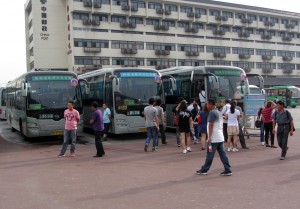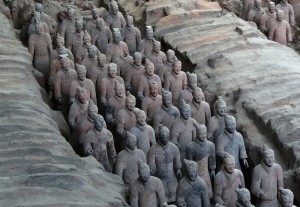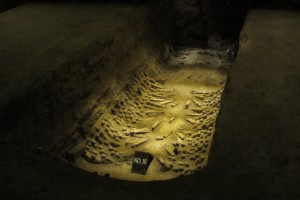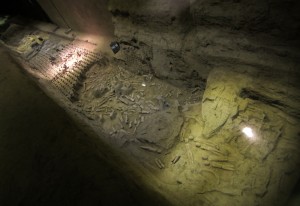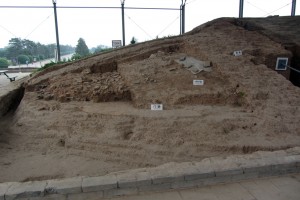So it’s 1974, and you’re a Chinese peasant in Xi’an. You and your peasant buddies are digging a well. You churn up some dirt… you notice a shard of terracotta… and you discover an underground vault containing thousands of figures who have stood guard over an emperor’s tomb for over two millennia.
You’ve discovered the Army of Terracotta Warriors: archeological marvel and tourism goldmine. China’s top three tourist attractions (yes, we’ll visit all three) are the Great Wall, the Forbidden City, and the Terracotta Army.
When the first Emperor of China, Qin Shi Huang, died in the 3rd Century BC, he was laid to rest in a mausoleum surrounded by a series of large structures. Inside stood intricately-sculpted terracotta soldiers, archers, horses, and chariots. An army to join him in the next world.
They couldn’t defend him in this one. After making off with weapons and other artifacts, looters set fire to the buildings. The wooden rafters caved in, crushing the figures and concealing them from passing eyes for centuries.
There are plenty of all-inclusive tours to see the Army, but we wanted to explore on our own schedule, so we took local bus 306. Step one: make sure you’re actually getting on the 306 bus (fare: 7 yuan/US$1.15). Numerous other buses park in the same area and pretend to be the 306 (fare: a lot more than 7 yuan).
Arriving at the site, you experience the tourist goldmine before the archeological marvel. We paid for our tickets, paid extra for audioguides, and then walked the gauntlet of shops and restaurants.
It was worth it. After watching a cheesy 360-degree movie, we took Lonely Planet’s advice and proceeded in reverse order from the tour groups. Starting in the smaller Pit 3, we saw examples of how the soldiers were discovered, shattered and scattered- a helmet here, a horse’s ear there. In Pit 2, which is larger, you begin to appreciate the scale of this memorial. And then it hits you: the massive Pit 1, with thousands of reconstructed figures back in formation, after all these years.
I don’t mean to suggest that the Chinese government is untrustworthy, but we did (semi)jokingly wonder if this is all a hoax, and there’s a factory in Shenzhen churning out Terracotta Warriors as fast as it can. As far as I can tell, they’re the real thing, and they’re incredible.
Armies of tourists descend upon the Terracotta Army every day. Far fewer bother ol’ Emperor Jingdi, further outside of Xi’an. Our hostel arranged for a private driver to take a group of us to the Han Yang Ling Museum. Emperor Jingdi and his father Wendi are remembered for ushering a harmonious era of cooperation with the nearby communities. As at the Terracotta Army site, numerous carved figures were assembled to accompany the Emperor into the afterlife.
Unlike at the Terracotta Army site, you can get close to these figures and even walk over some of the actual dig sites, with a glass floor allowing you to view the discoveries below in situ. Booties are provided.
[youtube_sc url=”http://youtu.be/ZYDHeTY1MTY”]
Outside, you can view an outdoor excavation in progress.
Watch where you step around Xi’an. You never know what- or who- might be down there.


